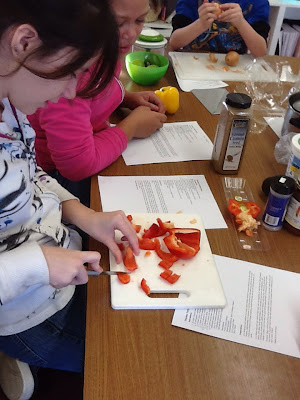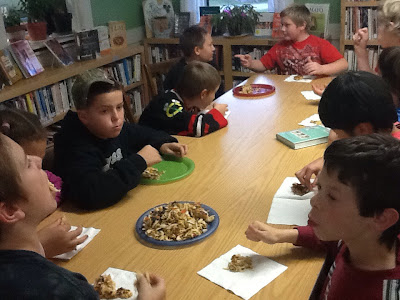...but if I plumb my mind I can remember the hectic days before vacation. In a fit of what I hoped was inspiration, I decided that I wouldn't ask parents to send in food for a holiday party on the last day of school before vacation. Instead, we would cook our own feast -- a celebration of southwestern cuisine. Parents were invited to cook with us in the morning or eat with us in the afternoon. Although kids were disappointed to learn that we wouldn't be cooking immense steaks in homage to Texas ranchers, they did approve of the final menu.
Last Thursday morning after snack, we split into three groups to make our three courses.
Each group started off by reading their recipe and doing the math together to double the ingredients. I put some Salsa music on as we cooked and was pleased to see how each dish came together quickly.
One group started off baking cornbread for a cornbread salad that included bacon, hard boiled eggs, pickles and roasted red peppers.

A second group made chicken tortilla soup. They also prepped all the toppings for the soup. A parent volunteer joined this group and worked with her son through the whole process.

I worked with a third group, who made a chocolate pudding spiced with chile and cinnamon.

One student in my group didn't feel like waiting around for his turn to do a step of the pudding, and instead wandered around taking pictures of all three groups. (He also took it upon himself to sample a sliver of the baker's chocolate being chopped in the above picture. Let us just say: Lesson Learned.) As he took pictures, he made it his mission to capture an action shot of an egg being cracked.
 Another student took an obsessive interest in the bacon as it cooked on the stove and took picture after picture after picture. When I got home that night, I discovered he had taken 42 pictures in all! For anyone who's ever read Douglas Adams Hitchhiker books, you'll understand why I might be thinking the meaning of life involves bacon...
Another student took an obsessive interest in the bacon as it cooked on the stove and took picture after picture after picture. When I got home that night, I discovered he had taken 42 pictures in all! For anyone who's ever read Douglas Adams Hitchhiker books, you'll understand why I might be thinking the meaning of life involves bacon...
As groups finished up, kids chose to cut out snowflakes or read a book and I snagged two students at a time to help wash and dry dishes.
After lunch, I settled kids into a Food Network Challenge show that pitted four chefs against each other creating four foot high chocolate creations that included moving parts.
As we were setting up, I heard one student say, "The kids in [another teacher's] class are watching [some comedy movie]."
I tensed up. Was I lame for making them watch the Food Network?
Another student quickly chimed in, (not for my benefit) "But this is better." Excellent!
After the show was over I assembled the food buffet style and let each group say something about their dish by way of introduction.

Then the eating! The soup was very lime-y, the cornbread salad a lot like a yummy stuffing, and the pudding was super-delish. Two parents joined us for the feasting.




Before I let anyone have seconds, we had a round of compliments for each dish, so that the cooks could hear what their audience thought. The soup was quite tangy, but several kids said they liked how it "waked up their mouths." The salad got positive reviews and everyone agreed the pudding was far superior to the store-bought stuff.
Seconds, clean-up, and vacation was in sight! A highlight of my day was standing at the end of the hall as kids charged outside toward freedom. I'm sure most of them didn't even hear me say, "Happy New Year" as they raced away, but one charming student took the time to say, "Thanks for the feast, Ms. G." as she left.
Happy New Year to you all! May everyone have enough healthy food to eat in 2012.








































